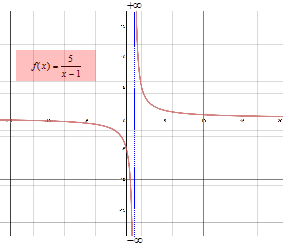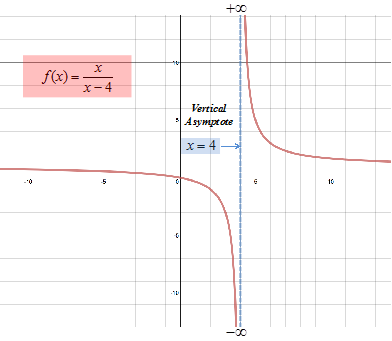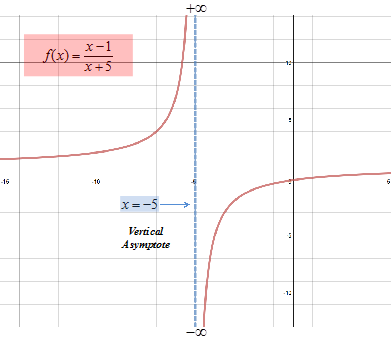Limits: Infinite Limits
|
x |
|
x |
|
|
0.9 |
-50 |
1.00001 |
500,000 |
|
0.99 |
-500 |
1.0001 |
50,000 |
|
0.999 |
-5000 |
1.001 |
5000 |
|
0.9999 |
-50,000 |
1.01 |
500 |
|
0.99999 |
-500,000 |
1.1 |
50 |

A limit in which f(x) increases or decreases without bound as the value of x approaches an arbitrary number c is called an infinite limit.
This does not mean that a limit exists or that is a number. In fact the limit does not exist. The values of simply tell how the limit fails to exist because the values as x approaches c increase/decrease without bound.
Infinite limits are denoted by:
and is read "the limit of f(x) as x approaches a is infinity".
DEFINITION OF AN INFINITE LIMIT
Let f(x) be a function that can be defined on either side of a point a, and may or may not be defined at a:
means as x approaches a, but not equal to a, the value of f(x) increase/decreases without bound.
The line at which the limit of a function increases or decreases without bound is called a vertical asymptote.
DEFINITION OF A VERTICAL ASYMPTOTE
The line x = a is a vertical asymptote of f(x) if one of the following is true:
Let's find the infinite limits in a couple examples.
|
Step 1: Find the Create a table of values for f(x) as or justify the behavior of the values for f(x). Do not include x = 4. |
As values for x get closer and closer to 4 but remain larger than 4, the denominator becomes a smaller and smaller positive number so the quotient becomes increasingly larger without bound.
|
||||||||||
|
Step 2: Find the Create a table of values for f(x) as or justify the behavior of the values for f(x). Do not include x = 4. |
As values for x get closer and closer to 4 but remain smaller than 4, the denominator becomes a smaller and smaller negative number so the quotient becomes increasingly large negative number without bound.
|
||||||||||
|
Step 3: Sketch the graph.
|
|||||||||||
|
Step 4: Define the vertical asymptote. Because ; , the line is a vertical asymptote. |
|||||||||||
|
Step 1: Find the Create a table of values for f(x) as or justify the behavior of the values for f(x). Do not include x = -5. |
As values for x get closer and closer to -5 but remain larger than -5, the denominator becomes a smaller and smaller positive number while the numerator approaches -6 so the quotient becomes increasingly negative without bound.
|
||||||||||
|
Step 2: Find the Create a table of values for f(x) as or justify the behavior of the values for f(x). Do not include x = -5. |
As values for x get closer and closer to -5 but remain smaller than -5, the denominator becomes a smaller and smaller negative number while the numerator approaches -6 so the quotient becomes an increasingly larger positive number without bound.
|
||||||||||
|
Step 3: Sketch the graph.
|
|||||||||||
|
Step 4: Determine if the function has a limit. Because ; , the line is a vertical asymptote. Because the limits increase without bound, no limit exists. Remember, an infinite limit is not a limit but merely states how the limit fails. |
|||||||||||
|
Related Links: Math algebra Limits: Limit Laws General Differentiation Rules Calculus Topics |
To link to this Limits: Infinite Limits page, copy the following code to your site:


